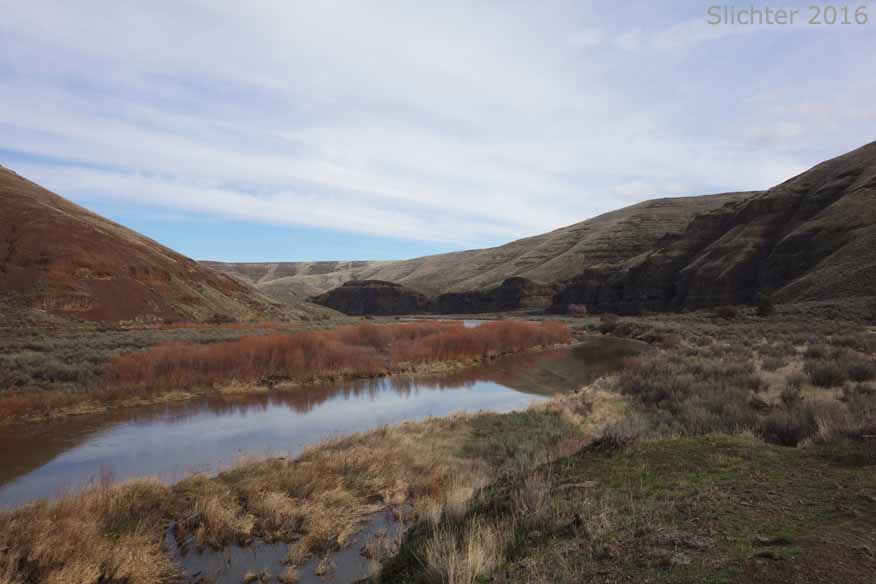
Additional Information for those planning to hike Cottonwood Canyon State Park:
Cottonwood Canyon Info: includes map showing BLM vs. Oregon State Park land. Even better maps are available from the BLM. http://oregonstateparks.org/index.cfm?do=main.loadFile&load=_siteFiles/publications/Cottonwood101301.pdf
Cottonwood Planned Trail Development: (scroll down for planned trails) http://www.oregon.gov/oprd/PLANS/docs/masterplans/cottonwood/cottonwood-plan-maps-ch10.pdf
Western Juniper: Juniperus occidentalis
* White Alder: Alnus rhombifolia
Western Hackberry: Celtis reticulata
Creek Dogwood: Cornus sericea
Coyote Willow: Salix exigua var. exigua
Cowpie Lichen: Diploschistes (muscorum ?)
Navel Lichen: Umbilicaria sp.
Scouring Rush: Equisteum hyemale
Ripgut Brome: Bromus diandrus
Cheat Grass: Bromus tectorum
Bottlebrush Squirreltail: Elymus elymoides (var. ?)
Barley: Hordeum sp. ?
Basin Wildrye: Leymus cinereus
Reed Canarygrass: Phalaris arundinacea
Bulbous Bluegrass: Poa bulbosa
Sandberg's Bluegrass: Poa secunda (ssp. ?) ?
Bluebunch Wheatgrass: Pseudoroegneria spicata
Sagebrush Mariposa: Calochortus macrocarpus var. macrocarpus - Leaves only.
Bicolored Cluster Lily: Triteleia grandiflora - Basal leaves present.
Northern Buckwheat: Eriogonum compositum var. compositum
Snow Buckwheat: Eriogonum niveum ?
Prickly Russian Thistle: Salsola tragus
Western Clematis: Clematis ligusticifolia
Hornseed Buttercup: Ranunculus testiculatus - In bud.
* Spring Whitlow-grass: Draba verna - In bud.
* Scalepod: Idahoa scapigera
Whitetop: Lepdium appellianum ? - Dried remains of last year's plants.
Tall Tumblemustard: Sisymbrium altissimum
Cut-leaf Thelypody: Thelypodium laciniatum - New basal leaf foliage. On cliffs.
Leiberg's Stonecrop: Sedum leibergii - In bud.
Alpine Alumroot: Heuchera cylindrica var. alpina
* Smooth Prairie Star: Lithophragma glabrum - Non bulblet form.
Brittle-leaved Saxifrage: Micranthes fragosa ? - Leaves only.
Nesting Saxifrage: Micranthes nidifica ? - A few plants with flower buds.
Golden Currant: Ribes aureum - Leafing out. A few flower buds.
Mock Orange: Philadelphus lewisii
Sticky Cinquefoil: Drymocallis sp. ? - Basal leaves.
Pearhip Rose: Rosa woodsii var. ultramontana
Himalayan Blackberry: Rubus bifrons
American Licorice: Glycyrrhiza lepidota
Longspur Lupine: Lupinus (arbustus ?) - Leaves just coming out of the ground.
Filaree: Erodium cicutarium
Western Sumac: Rhus glabra
Poison Ivy: Toxicodendron rydbergii
Hedge-parsley: Caucaulis microcarpus ?
Poison Hemlock: Conium maculataum
* Canby's Desert Parsley: Lomatium canbyi
Fernleaf Desert Parsley: Lomatium dissectum var. multifidum
* Salt and Pepper: Lomatium gormanii
* Pungent Desert Parsley: Lomatium grayi - Beginning to bloom.
* Henderson's Desert Parsley: Lomatium hendersonii
Silverleaf Phacelia: Phacelia hastata var. hastata
Branching Phacelia: Phacelia ramosissima var. subglabra
Fiddleneck: Amsinckia sp. - Basal leaves.
Common Monkeyflower: Erythranthe guttata
Dalmatian Toadflax: Linaria dalmatica
Cutleaf Penstemon: Penstemon richardsonii var. dentatus
Common Mullein: Verbascum thapsus
Blue Elderberry: Sambucus nigra ssp. caerulea
Yarrow: Achillea millefolium
Stiff Sagebrush: Artemisia rigida
Big Sagebrush: Artemisia tridentata ssp. tridentata
Carey's Balsamroot: Balsamorhiza careyana - Leaves beginning to poke out from the dried remains of last year's dried leaves.
Diffuse Knapweed: Centaurea diffusa
Hoary Goldaster: Heterotheca villosa (var. ?)
Wavyleaf Thistle: Cirsium undulatum
* Goldstars: Crocidium multicaule
Showy Rubber Rabbitbrush: Ericameria nauseosa (var. speciosa ?)
Columbia Goldenweed: Ericameria resinosa
Matchbrush: Gutierrezia sarothrae
Scotch Thistle: Onopordum acanthium
Skeletonweed: Stephanomeria (tenuifolia ?)
Bighorn Sheep - About 30.
Mule Deer - Tracks and scat.
Canada Geese - Active along the banks of the John Day River.
Common Mergansers
Mallards
Pheasants
Red-tailed Hawk
Ravens
Common Flicker - Feathers remaining from a feast.
Varied Thrush - In white alders along the river.
Says Phoebe - Probably the first day or two at this location. Migrating through or setting up nesting territory?
Song Sparrows
Bewick's Wren
Rock Wrens - Calling on the cliffs.
Bushtits - Very numerous in riparian shrubs and trees and throughout the sagebrush on the flats lining the river.
Jerusalem Cricket